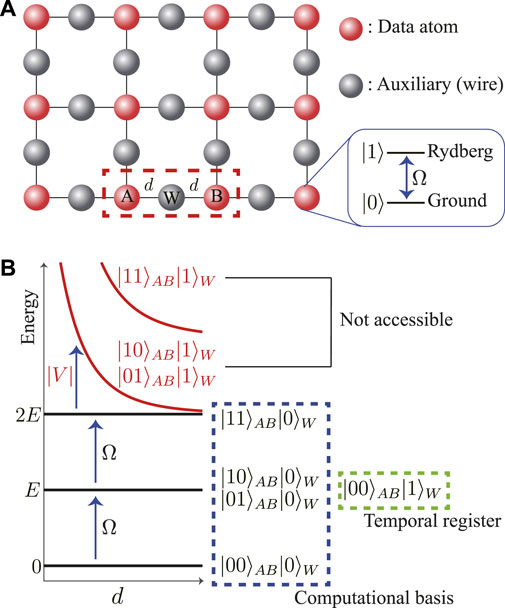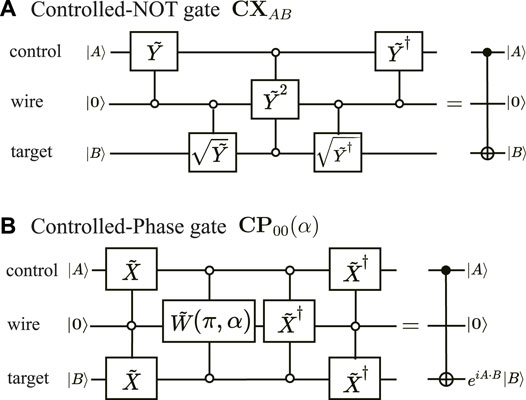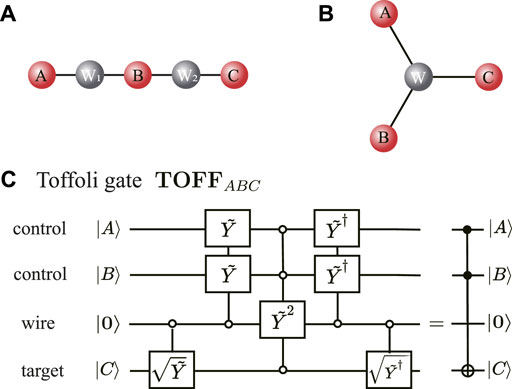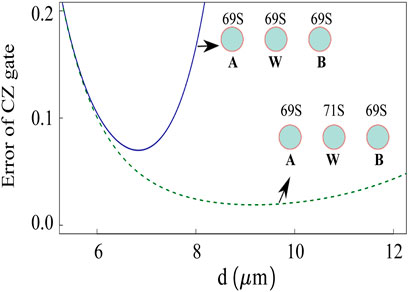- 1Department of Physics, KAIST, Daejeon, South Korea
- 2School of Physics, Xidian University, Xi’an, China
Rydberg atom arrays offer flexible geometries of strongly interacting neutral atoms, which are useful for many quantum applications such as quantum simulation and quantum computation. Here, we consider an all-optical gate-based quantum computing scheme for the Rydberg atom arrays, in which auxiliary atoms (wire atoms) are used as a mean of quantum-mechanical remote-couplings among data-qubit atoms, and optical individual-atom addressing of the data and wire atoms is used to construct universal quantum gates of the data atoms. The working principle of our gates is to use the wire atoms for coupling mediation only, while leaving them in noncoupling ground states before and after each gate operation, which allows the double-excited states of data qubits to be accessible by a sequence of π or π/2 pulses addressing the data and wire atoms. Optical pulse sequences are constructed for standard one-, two-, and multi-qubit gates, and the arbitrary two-qubit state preparation is considered for universal computation prospects. We further provide a detailed resource estimate for an experimental implementation of this scheme in a Rydberg quantum simulator.
1 Introduction
Quantum computing is being actively studied as a mean to revolutionize humankind’s computational capability beyond the limits of digital computers [1, 2]. Quantum computing hardware are two-level physical systems, which we refer to as qubits hereafter, and quantum computation performs operations of universal quantum gates on them. Gate-based quantum computations have been demonstrated in many physical systems, including linear optics [3, 4], circuit quantum electrodynamics of superconductor [5–7], trapped ions [8–10], defects in solid-state materials [11, 12], and neutral atoms [13, 14].
Neutral atoms have been considered for gate-based quantum computations using interactions between the Rydberg atoms [15, 16]. The advantages of using Rydberg atoms are strong dipole–dipole interactions that can be switched on and off by fast laser excitation, large-scale atom arrays that can be prepared with almost any desired geometries and topologies [17–19], and stable ground hyperfine states that can be used for long-term quantum information. Quantum gates using Rydberg atoms can utilize the distance-dependent interactions [20] or the Rydberg blockade effect which prohibits adjacent atoms from being excited to a Rydberg state [21, 22]. There are many Rydberg atom schemes for quantum gates and entanglements [23–26] and experimental demonstrations [27–31, 33, 34]. The single-qubit gate fidelity of the recent demonstrations was recorded 0.97 in the alkali atom system [29] and 0.99 in the alkaline-earth atomic system [31]. Many of these previous studies are based on coding quantum information in the stable states, which are the hyperfine-Zeeman substates, requiring a hybrid microwave or Raman excitation scheme in addition to Rydberg atom excitation.
In this article, we consider an all-optical quantum gate scheme in a Rydberg atom array, which does not resort to the ground sublevels and, instead, utilizes auxiliary atoms (wire atoms) to mediate coupling among qubit atoms (data atoms), and single-atom addressing operations. When we use a Rydberg state and ground state to be the two qubit states for a data qubit and use a cluster of data and wire qubits in a Rydberg atom array, in which the wire atoms between the data qubits mediate interactions between the data atoms, by a sequence of single-atom addressing operations. The advantage of this setup comes in twofold. First, the gates are all realized with fast laser excitation of the ground-Rydberg transitions, so that the quantum circuit for a certain computational task (including digital quantum simulation) can be carried out fast. Second, the distance between the data atoms can be large, for which analyses shown later with practical and currently available resources estimates that, for example, a CZ gate between two atoms separated about 19 μm could be created with a high fidelity over 98% within a duration 2π/Ω, where Ω is the Rydberg Rabi frequency.
In the rest of the article, we first outline the main idea of the quantum wire gates based on the Rydberg interaction and single-atom addressing in Section 2, and then construct single- and two-qubit gates in Sections 3, 4. We then discuss the general two-qubit state generation and multi-qubit gates in Sections 5, 6. Experimental implementations, gate performances, and alternative schemes are discussed in Section 7.
2 Single-Atom Addressing in a Rydberg-Atom System
We aim to construct quantum gates with a sequence of individual-atom addressing in an array of atoms. We consider a two-dimensional (2D) array of atoms as shown in Figure 1A. In the Rydberg blockade regime, adjacent two atoms are inhibited from being excited to an antiblockade state, |11⟩, so the computational space of the two atoms is limited to {|00⟩, |01⟩, |10⟩} excluding |11⟩ (the antiblockade two-atom state), when the two-level system, {|0⟩, |1⟩}, is defined with the ground and Rydberg states of each atom. However, because |11⟩ is necessary for general quantum computation, we use the auxiliary atoms (which we refer to as wire atoms, hereafter) to mediate couplings among the data atoms. In Figure 1A, data atoms are illustrated with red spheres and wire atoms are with gray spheres.

FIGURE 1. The Rydberg wire gate scheme: (A) A 2D atomic array consists of data atoms (red spheres) and auxiliary (wire) atoms (gray spheres). Atomic ground state |0⟩ and Rydberg state |1⟩ are used for the two-level system of each atom. Wire atoms, e.g., W, mediate the couplings between two adjacent data atoms, e.g., A and B which are separated from W by a distance d. (B) The energy level diagram of the three atoms, A, W, and B. We use four computational basis states, |00⟩AB|0⟩W, |01⟩AB|0⟩W, |10⟩AB|0⟩W, and |11⟩AB|0⟩W (in the blue dashed rectangle), out of five accessible states including |00⟩AB|1⟩W, which is considered as a temporal register (in the light green dashed rectangle). The other states, |10⟩AB|1⟩W, |01⟩AB|1⟩W, and |11⟩AB|1⟩W are not accessible due to the Rydberg blockade.
In the three-atom system, AWB in Figure 1A, A and B are the data atoms and W is the wire atom to couple A and B. When the wire atom is excited to |1⟩, only for data processing of |AB⟩ and otherwise left to be |0⟩W, there are five computational base states |00⟩AB|0⟩W, |01⟩AB|0⟩W, |10⟩AB|0⟩W, |11⟩AB|0⟩W, and |00⟩AB|1⟩W. Here, the first four base states are the computational basis for the two-data (AB) system and the last |00⟩AB|1⟩W can be considered as a temporal register, as in Figure 1B. There are three available atom addressings:
where Θ and ϕ are the Rabi rotation angle and axis, respectively. HW is the Hamiltonian of single-addressing of W given by
in the Rydberg blockade regime of adjacent atoms, i.e.,
It is noted that the atom-addressing operations in Eqs 1a–c are three-qubit gates. We intend to use them for general quantum computations of the data AB atoms.
where R is the single-qubit rotation and I is the identity.
3 Standard One-Qubit Gates
With the atom-addressing operations,
Pauli gates rotate the quantum state of one atom, while leaving the other atoms unchanged. For the data atoms, A and B, Pauli X-gates are given by
where
where
The Hadamard gate, H, converts the quantum states, |0⟩ and |1⟩, to the superposition states,
where
The phase gates, PA(ϕ) and PB(ϕ), are given by
S and T gates are obtained as SA = PA(π/2), SB = PB(π/2), TA = PA(π/4), and TB = PB(π/4).
The global phase, α, of the abovementioned gates can be eliminated with a global phase gate. One example is
which is a combination of four two-qubit phase rotations, |00⟩ → eiα|00⟩ which is performed by
4 Standard Two-Qubit Gates
Now, we consider the standard two-qubit gates including the controlled-NOT gate, CNOT, the swap gate, SWAP, and the controlled-phase gate, CP.
The controlled-NOT gate, CNOT, flips the target qubit (the second qubit) only when the control qubit (the first qubit) is in |1⟩, i.e., |AB⟩ → |A, A ⊕ B⟩, which is also the controlled X-gate, i.e., CNOT = CX. With the atom addressing, CXAB and CXBA are, respectively, given by
of which the sequence can be understood as follows: In CXAB,
which is then multiplied by

FIGURE 2. Quantum circuits of (A) controlled-NOT gate, CXAB, and (B) controlled-phase gate, CP00(α).
SWAP gate performs the state swapping of two qubits, i.e., |AB⟩ → |BA⟩, which is also the exchange of the coefficients of |01⟩ and |10⟩. In our atom-addressing scheme, an X-gate version of SWAP gate is given by
in which the first three-pulse combination,
The controlled-phase gate, CP(α), puts the local phase of |11⟩ of AB data qubits. In our atom-addressing scheme, W-atom addressing,
The quantum circuit of CP00(α) is presented in Figure 2B. The standard CP(α) = CP11(α) is, therefore, obtained by
where the CP00(α) in the middle is multiplied by
5 Arbitrary Two-Qubit State Generation
The general two-qubit state generation is to find a unitary operation which transforms the initial state |00⟩AB to an arbitrary two-qubit state, i.e.,
The above U can be in principle constructed with the single- and two-qubit gates. Also, it is sufficient to define the general rotations and at least one inversion operation among the two-qubit base states, {|00⟩, |01⟩, |10⟩, |11⟩} of AB atoms.
Inversion operations are the reflection of the two-qubit state vector about a given plane. For example, CZ inverts the state vector about the plane orthogonal to |11⟩, i.e.,
General rotations are the base-pair rotation between a pair of two-qubit base states, i.e.,
where the first two π-pulse operations,
6 Multi-Qubit Gates
While the multi-qubit gates can be decomposed to a sequence of single- and two-qubit elementary gates, the standard three-qubit gates require many elementary gates. For example, a Toffoli gate needs 15 or 17 elementary gates. In the following, we consider the possibilities of using wire atom arrangements which can reduce the number of gates significantly for the Toffoli and CCZ gates.
If we use the simple linear configuration, as in Figure 3A, of ABC data atoms and two wire atoms W1 and W2, their pulse-sequence solutions, e.g., for the Toffoli and CCZ gates, are rather complicated:

FIGURE 3. (A) A 5-atom chain and (B) an Y-shape atomic array to implement the multi-qubit wire gates. (C) Quantum circuit of the Toffoli gate TOFFABC for the control atoms A, B and the target atom C.
Instead, if we use the Y-shape configuration, as shown in Figure 3B, which has one wire atom, W, which couples all the three data atoms, ABC, simultaneously, their solutions are simple, given as the extensions of CX and CZ in Eqs 10a,b, 11. The CCZ utilizes the fact that
where
where
7 Discussion and Conclusion
Experimental implementation: Rydberg wire gates introduced previously can be implemented in optical-tweezer atomic systems, which have been previously demonstrated elsewhere [20, 29, 30]. As an example, we consider three rubidium (87Rb) atoms arranged in the linear chain geometry. Once the single atoms are loaded to individual tweezers from magneto-optical trap, the atoms are prepared to one of the magnetic sublevels in hyperfine ground states as the ground state |0⟩ (for example, |0⟩ = |5S1/2, F = 2, mF = 2⟩). The states |0⟩ and |1⟩ are coupled by Rydberg state excitation lasers, and in general two-photon excitation is used to transit to |nS⟩ or |nD⟩ Rydberg levels via |5P3/2⟩ with 780 and 480 nm lights. For |1⟩ = |69S1/2⟩, the atoms undergo van der Waals interaction, and the interaction strength when the interatomic distance d = 7 μm becomes
Gate performance: the performance of the Rydberg wire gate schemes can be estimated with numerical calculations. In Figure 4, we estimate the average fidelity of CP00(π) gate for all the initial states

FIGURE 4. Performance estimation of the CZ gate for the present van der Waals scheme (solid line) in comparison with the Förster resonance scheme (dashed line).
Gate imperfection sources: The sources of finite infidelities related to the Rydberg atomic properties can be characterized. The finite lifetime of Rydberg state gives imperfection to the transition to |1⟩. For the lifetime of |1⟩ to be τ, this gives the average gate error
where the terms denote the Rydberg state decay error, the Rydberg blockade error, and the residual interaction error, respectively. Their estimated infidelity contributions are 4 × 10−3, 2.04 × 10−2 and 9.12 × 10−2, respectively, at d = 6.8 μm. While our fidelity estimation considers limitedly sub-μs pulsed gate significantly shorter than the typical coherence time of Rydberg atoms, a detailed analysis, for example, in a large-scale quantum circuit requires many-body effects and open quantum system dynamics [39–43].Toward the higher fidelity gates, we discuss methods to improve the gate fidelity to suppress the last two errors in Eq. 25. One approach is to utilize the dipole–dipole interaction by Förster resonance between the nearest neighbor atomic pair. Near the principal quantum number n = 69 discussed previously, there exist two transition channels between the Rydberg pair states, |69S1/2 + 71S1/2⟩ ↔|69P3/2 + 70P1/2⟩ and |69S1/2 + 71S1/2⟩ ↔|69P1/2 + 70P3/2⟩ by the dipole–dipole interaction, with Förster defects of 6.6 and 19.7 MHz, respectively [44]. This induces the dipole–dipole interaction with the strength of V′ = C3/d3, where C3 = (2π)12.32 GHz ⋅ μm3, with the interatomic distance less than the crossover distance 11 μm [45]. In realizing the CP00(π) gate, the atom W is to be excited to |1′⟩ = |71S1/2, mj = 1/2⟩ state, while the data atoms A and B are excited to |1⟩. Then, the interaction strength between A(B) and W is increased due to the Förster resonance, so the interatomic distance can also be increased. This further reduces the long range residual van der Waals interaction between A and B, thus the gate infidelity can be suppressed. In Figure 4, we illustrate the improved performance of the CP00(π) gate of the dipole–dipole interaction (the dashed line). The overall fidelities
Weakness of the Rydberg wire gates: The weakness of the present scheme is that the Rydberg states are not stable. There is a constant decay process occurring during the quantum control process. However, for a fast quantum control process, the decay-induced error can be relatively small for the decay error and is proportional to the Rydberg superposition time. Moreover, the quantum error correction can, in principle, be executed by the gates shown in this article, so that the error during the control process can be corrected. Because both the main control process and error correction are fast. Thanks to the fast pulsed operations of quantum wire gates, the overall speed to reach a wanted computational result can still surpass the traditional method of coding information with the stable hyperfine-Zeeman substates.
In summary, the Rydberg wire gates are proposed, which utilize auxiliary atoms to couple the data atoms. By coding the information with a ground-state qubit state and a Rydberg qubit state, the universal gate set can be realized based on the strong, local interactions of the neutral Rydberg atoms. The gates are realized by the fast laser excitation of Rydberg states, so that their speed can be fast, and the well-separated data atoms can be rapidly entangled. Fast entangling operations are important basic elements in a quantum circuit for large-scale quantum computation, and long-distance entanglement can greatly simplify complex operations between distant qubits in the array. The new idea of Rydberg wire gates can bring new prospective in neutral-atom quantum science and technology.
Data Availability Statement
The original contributions presented in the study are included in the article/Supplementary Material. Further inquiries can be directed to the corresponding author.
Author Contributions
JA conceived the idea. SJ, XF-S, and MK conducted the research and analysis. All contributed to the manuscript.
Funding
This research was supported by the Samsung Science and Technology Foundation (Grant No. SSTF-BA1301-52), National Research Foundation of Korea (Grant No. 2017R1E1A1A0107430), and Natural Science Foundation of China (Grant No. 12074300).
Conflict of Interest
The authors declare that the research was conducted in the absence of any commercial or financial relationships that could be construed as a potential conflict of interest.
Publisher’s Note
All claims expressed in this article are solely those of the authors and do not necessarily represent those of their affiliated organizations, or those of the publisher, the editors, and the reviewers. Any product that may be evaluated in this article, or claim that may be made by its manufacturer, is not guaranteed or endorsed by the publisher.
References
1. Feynman RP. Simulating Physics with Computers. Int J Theor Phys (1982) 21:467–88. doi:10.1007/bf02650179
2. Nielsen MA, Chuang I. Quantum Computation and Quantum Information. Cambridge: Cambridge Univ. Press (2002).
4. Kok P, Munro WJ, Nemoto K, Ralph TC, Dowling JP, Milburn GJ. Linear Optical Quantum Computing with Photonic Qubits. Rev Mod Phys (2007) 79:135–74. doi:10.1103/revmodphys.79.135
5. Arute F, Arya K, Babbush R, Bacon D, Bardin JC, Barends R, et al. Quantum Supremacy Using a Programmable Superconducting Processor. Nature (2019) 574:505–10. doi:10.1038/s41586-019-1666-5
6. Krantz P, Kjaergaard M, Yan F, Orlando TP, Gustavsson S, Oliver WD. A Quantum Engineer's Guide to Superconducting Qubits. Appl Phys Rev (2019) 6:021318. doi:10.1063/1.5089550
7. Blais A, Grimsmo AL, Girvin SM, Wallraff A. Circuit Quantum Electrodynamics. Rev Mod Phys (2021) 93:025005. doi:10.1103/revmodphys.93.025005
8. Kielpinski D, Monroe C, Wineland DJ. Architecture for a Large-Scale Ion-Trap Quantum Computer. Nature (2002) 417:709–11. doi:10.1038/nature00784
9. Schindler P, Nigg D, Monz T, Barreiro JT, Martinez E, Wang SX, et al. A Quantum Information Processor with Trapped Ions. New J Phys (2013) 15:123012. doi:10.1088/1367-2630/15/12/123012
10. Pogorelov I, Feldker T, Marciniak CD, Postler L, Jacob G, Kriegelsteiner O, et al. Compact Ion-Trap Quantum Computing Demonstrator. PRX Quan (2021) 2:020343. doi:10.1103/prxquantum.2.020343
11. van der Sar T, Wang ZH, Blok MS, Bernien H, Taminiau TH, Toyli DM, et al. Decoherence-protected Quantum gates for a Hybrid Solid-State Spin Register. Nature (2012) 484:82–6. doi:10.1038/nature10900
12. Childress L, Hanson R. Diamond NV Centers for Quantum Computing and Quantum Networks. MRS Bull (2013) 38:134–8. doi:10.1557/mrs.2013.20
13. Weiss DS, Saffman M. Quantum Computing with Neutral Atoms. Phys Today (2017) 70:44–50. doi:10.1063/pt.3.3626
14. Henriet L, Beguin L, Signoles A, Lahaye T, Browaeys A, Reymond G-O, et al. Quantum Computing with Neutral Atoms. Quantum (2020) 4:327. doi:10.22331/q-2020-09-21-327
15. Saffman M, Walker TG, Mølmer K. Quantum Information with Rydberg Atoms. Rev Mod Phys (2010) 82:2313–63. doi:10.1103/revmodphys.82.2313
16. Saffman M. Quantum Computing with Atomic Qubits and Rydberg Interactions: Progress and Challenges. J Phys B: Mol Opt Phys (2016) 49:202001. doi:10.1088/0953-4075/49/20/202001
17. Kim M, Song Y, Kim J, Ahn J. Quantum Ising Hamiltonian Programming in Trio, Quartet, and Sextet Qubit Systems. PRX Quan (2020) 1:020323. doi:10.1103/PRXQuantum.1.020323
18. Song Y, Kim M, Hwang H, Lee W, Ahn J. Quantum Simulation of Cayley-Tree Ising Hamiltonians with Three-Dimensional Rydberg Atoms. Phys Rev Res (2021) 3:013286. doi:10.1103/PhysRevResearch.3.013286
19. Kim M, Kim K, Hwang J, Moon E-G, Ahn J. Rydberg Quantum Wires for Maximum Independent Set Problems. Nat Phys (2022). doi:10.1038/s41567-022-01629-5
20. Jo H, Song Y, Kim M, Ahn J. Rydberg Atom Entanglements in the Weak Coupling Regime. Phys Rev Lett (2020) 124:033603. doi:10.1103/PhysRevLett.124.033603
21. Gaëtan A, Miroshnychenko Y, Wilk T, Chotia A, Viteau M, Comparat D, et al. Observation of Collective Excitation of Two Individual Atoms in the Rydberg Blockade Regime. Nat Phys (2009) 5:115–8. doi:10.1038/nphys1183
22. Urban E, Johnson TA, Henage T, Isenhower L, Yavuz DD, Walker TG, et al. Observation of Rydberg Blockade between Two Atoms. Nat Phys (2009) 5:110–4. doi:10.1038/nphys1178
23. Jaksch D, Cirac JI, Zoller P, Rolston SL, Côté R, Lukin MD. Fast Quantum Gates for Neutral Atoms. Phys Rev Lett (2000) 85:2208–11. doi:10.1103/physrevlett.85.2208
24. Shi X-F. Deutsch, Toffoli, and CNOT Gates via Rydberg Blockade of Neutral Atoms. Phys Rev Appl (2018) 9:051001. doi:10.1103/physrevapplied.9.051001
25. Shi X-F. Transition Slow-Down by Rydberg Interaction of Neutral Atoms and a Fast Controlled-Not Quantum Gate. Phys Rev Appl (2020) 14:054058. doi:10.1103/physrevapplied.14.054058
26. Saffman M, Beterov II, Dalal A, Páez EJ, Sanders BC. Symmetric Rydberg Controlled-Z gates with Adiabatic Pulses. Phys Rev A (2020) 101:062309. doi:10.1103/physreva.101.062309
27. Isenhower L, Urban E, Zhang XL, Gill AT, Henage T, Johnson TA, et al. Demonstration of a Neutral Atom Controlled-Not Quantum Gate. Phys Rev Lett (2010) 104:010503. doi:10.1103/PhysRevLett.104.010503
28. Levine H, Keesling A, Omran A, Bernien H, Schwartz S, Zibrov AS, et al. High-Fidelity Control and Entanglement of Rydberg-Atom Qubits. Phys Rev Lett (2018) 121:123603. doi:10.1103/physrevlett.121.123603
29. Levine H, Keesling A, Semeghini G, Omran A, Wang TT, Ebadi S, et al. Parallel Implementation of High-Fidelity Multiqubit Gates with Neutral Atoms. Phys Rev Lett (2019) 123:170503. doi:10.1103/physrevlett.123.170503
30. Graham TM, Kwon M, Grinkemeyer B, Marra Z, Jiang X, Lichtman MT, et al. Rydberg-Mediated Entanglement in a Two-Dimensional Neutral Atom Qubit Array. Phys Rev Lett (2019) 123:230501. doi:10.1103/physrevlett.123.230501
31. Madjarov IS, Covey JP, Shaw AL, Choi J, Kale A, Cooper A, et al. High-fidelity Entanglement and Detection of Alkaline-Earth Rydberg Atoms. Nat Phys (2020) 16:857–61. doi:10.1038/s41567-020-0903-z
32. Maller KM, Lichtman MT, Xia T, Sun Y, Piotrowicz MJ, Carr AW, et al. Rydberg-blockade Controlled-Not Gate and Entanglement in a Two-Dimensional Array of Neutral-Atom Qubits. Phys Rev A (2015) 92:022336. doi:10.1103/physreva.92.022336
33. Graham TM, Song Y, Scott J, Poole C, Phuttitarn L, Jooya K, et al. Demonstration of Multi-Qubit Entanglement and Algorithms on a Programmable Neutral Atom Quantum Computer (2021). arXiv:2112.14589.
34. Schine N, Young AW, Eckner WJ, Martin MJ, Kaufman AM. Long-lived Bell States in an Array of Optical Clock Qubits (2021). arXiv:2111.14653.
35. Omran A, Levine H, Keesling A, Semeghini G, Wang TT, Ebadi S, et al. Generation and Manipulation of Schrödinger Cat States in Rydberg Atom Arrays. Science (2019) 365(6453):570–4. doi:10.1126/science.aax9743
36. Shi X-F. Rydberg Quantum gates Free from Blockade Error. Phys Rev Appl (2017) 7:064017. doi:10.1103/physrevapplied.7.064017
37. Saffman M, Walker TG. Analysis of a Quantum Logic Device Based on Dipole-Dipole Interactions of Optically Trapped Rydberg Atoms. Phys Rev A (2005) 72:022347. doi:10.1103/physreva.72.022347
38. Shi X-F. Quantum Logic and Entanglement by Neutral Rydberg Atoms: Methods and Fidelity. Quan Sci. Technol. (2022) 7:023002. doi:10.1088/2058-9565/ac18b8
39. Chen X-Y, Zhang N-N, He W-T, Kong X-Y, Tao M-J, Deng F-G, et al. Global Correlation and Local Information Flows in Controllable Non-markovian Open Quantum Dynamics. Npj Quan Inf (2022) 8:22. doi:10.1038/s41534-022-00537-z
40. Tao M-J, Zhang N-N, Wen P-Y, Deng F-G, Ai Q, Long G-L. Coherent and Incoherent Theories for Photosynthetic Energy Transfer. Sci Bull (2020) 65:318–28. doi:10.1016/j.scib.2019.12.009
41. Ishizaki A, Fleming GR. Theoretical Examination of Quantum Coherence in a Photosynthetic System at Physiological Temperature. Proc Natl Acad Sci U.S.A (2009) 106:17255–60. doi:10.1073/pnas.0908989106
42. Wang B-X, Tao MJ, Ai Q, Xin T, Lambert N, Ruan1 D, et al. Efficient Quantum Simulation of Photosynthetic Light Harvesting. Npj Quan Inf (2018) 4:5625. doi:10.1038/s41534-018-0102-2
43. Zhang N-N, Tao M-J, He W-T, Chen X-Y, Kong X-Y, Deng F-G, et al. Efficient Quantum Simulation of Open Quantum Dynamics at Various Hamiltonians and Spectral Densities. Front Phys (2021) 16:51501. doi:10.1007/s11467-021-1064-y
44. Weber S, Tresp C, Menke H, Urvoy A, Firstenberg O, Büchler HP, et al. Calculation of Rydberg Interaction Potentials. J Phys B: Mol Opt Phys (2017) 50:133001. doi:10.1088/1361-6455/aa743a
Keywords: quantum gates, Rydberg atom, CNOT, Toffoli, quantum computation
Citation: Jeong S, Shi X-F, Kim M and Ahn J (2022) Rydberg Wire Gates for Universal Quantum Computation. Front. Phys. 10:875673. doi: 10.3389/fphy.2022.875673
Received: 14 February 2022; Accepted: 23 May 2022;
Published: 04 July 2022.
Edited by:
Aixi Chen, Zhejiang Sci-Tech University, ChinaReviewed by:
Guin-Dar Lin, National Taiwan University, TaiwanQing Ai, Beijing Normal University, China
Copyright © 2022 Jeong, Shi, Kim and Ahn. This is an open-access article distributed under the terms of the Creative Commons Attribution License (CC BY). The use, distribution or reproduction in other forums is permitted, provided the original author(s) and the copyright owner(s) are credited and that the original publication in this journal is cited, in accordance with accepted academic practice. No use, distribution or reproduction is permitted which does not comply with these terms.
*Correspondence: Jaewook Ahn, andhaG5Aa2Fpc3QuYWMua3I=
 Seokho Jeong
Seokho Jeong Xiao-Feng Shi
Xiao-Feng Shi Minhyuk Kim
Minhyuk Kim Jaewook Ahn
Jaewook Ahn